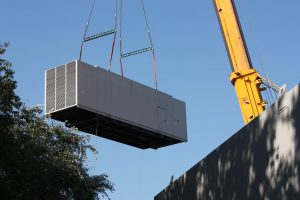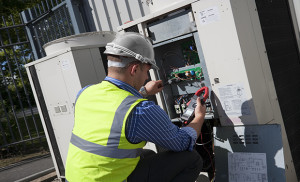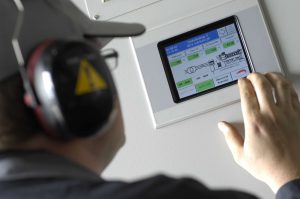A resilient system for data centre power protection and security is critical to business continuity and resilience. That’s a given. Although there are various elements to a full turnkey standby power solution including; UPS systems, battery banks, power distribution networks, switch gear, bulk fuel storage etc, we’ve chosen to focus the attention on generators in this article, which is undoubtedly the keystone to the power support structure.
But what should you consider in the specification and installation of Standby Generators? The following project stages highlight what to take into consideration, and how to design out the risks and commonly experienced hurdles before installation begins.
1) Initial Power System Survey
An initial review of the existing incoming mains power supply has to be the first place to start. What size supply will you need? Can the National Grid provide the power you need? What are your existing maximum loads? What are your business priorities and service level agreements? The survey ought to review all the physical considerations and limitations of your buildings and site.
2) Power System Design
Depending on your needs, the design stage should consider the physical, environmental and health and safety aspects of the generator installation and housing. So, it’s at this point you’ll need to think about noise regulations, physical location, fuel storage, cabling and access.
In data centres an N+1 generator and UPS configuration is a must. However, there are different levels of resilience that can be designed, depending on datacentre client requirements and SLA’s. (For example a datacentre responsible for providing solutions for government and banking sectors will require higher resilience than for non-business critical online storage.) This will provide a truly robust system for you and peace of mind for your clients with the knowledge that their data is in safe hands.
Consideration should be given for future growth and expansion planning. Demand peaks and troughs and PDU locations should also be reviewed at survey stage to enable the best possible system design. Think about where your business will be in 5 years’ time; will your generator still have the capacity to cover your projected load requirements?
3) Standby Po wer Technical Advice
wer Technical Advice
Changing, adapting or adding to an older power infrastructure isn’t always straightforward. The financial implications of a partial upgrade may be higher than a more cost-effective entire infrastructure replacement project.
Regardless of your initial assumptions it’s essential to make sure you get sound technical advice from a proven provider to ensure that the solution you go with is most suited to your requirements.
4) Scheduling and Delivery of Generator
Delivering small generators – between 10kVA – 200kVA – is normally a reasonably straightforward process. But for most central data centre projects the generator is likely to be larger than this, and therefore more substantial. These will need to be delivered complete with separate bulk fuel tanks, cable systems and electrical distribution panels by specialist heavy haulage contractors involving the appropriate craneage. If this is the case then consultation with all appropriate agencies (local authorities, highways agency and emergency services) may be required.
You may also need detailed location and transport surveys and, where necessary, consider for; weight and height limitations, specially arranged access, road closures, etc.
Make sure you have confidence not only in the product but the essential service and support that you need with its delivery and installation.
New build data centres are easier to work with, especially if the building was designed and built for that purpose. Older buildings (or buildings that have been subject to change of use) often present challenging access restrictions. Make sure provision is made for this; not just at delivery but previously during the installation design stage.
5) Generator & Pow er System Installation
er System Installation
Successful installation is a carefully planned sequence of events.
Some sites may require planning permissions and minor civil engineering works. This should be taken care of during the design process.
During installation, supervision of civil works may be required. Liaison with your local authority on planning permission and design approvals, co-ordination with your utilities companies about LV and HV shutdowns. Also required, where relevant, is management of all communications between building and premises landlords, architects and design authorities.
All areas of risk should have been designed out at stage 2. Make sure you work with someone who has the qualifications and experience to know some of the common pitfalls, and more importantly what to do to prevent things going wrong in the first place.
Getting this wrong can result in disruption to your business, and for business critical data centres this is just not an option.
6) Power System Commissioning
Commissioning the completed installation is an inspection and test process that ensures everything is safely and correctly installed and connected, fuelled and functioning exactly as it should be before integrating with the mains electrical supply. Initial load testing should be carried out, using a series of step load tests ultimately involving 100%+ load simulation on the generator for prolonged time periods with fully documented test results.
Actual building load testing is a nerve racking time as you watch the power to your data centre go down, the UPS, and then standby generator kick in. But, seeing it will give you the peace of mind that you have designed a resilient system to cope with the unexpected.
There’s no greater reassurance than the moment you see what you’ve asked for (and a system that has been designed to meet those requirements) primed and ready to perform.

7) Generator and Power System Maintenance
All aspects of standby power systems need to be as robust as possible, but particularly the generator element where the high mechanical content is reliant on regular service and maintenance in order to continue to produce optimum performance.
It’s incredibly rare for a complete standby power train (UPS, standby generator and prime power supply) to suffer major failure, but to protect your data centre make sure you have a regular programme of planned maintenance in place for each element.
Regular servicing and a comprehensive planned preventative maintenance regime, including regular load bank testing will ensure your system stays online at its optimum performance level.
To take the first step towards obtaining a suitable standby power solution for your data centre make contact with one of the UK’s leading technical experts in this field and book your initial survey.

